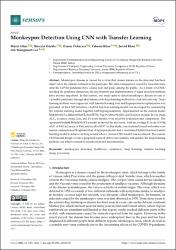Monkeypox Detection Using CNN with Transfer Learning
Citation
Altun, M.; Gürüler, H.; Özkaraca, O.; Khan, F.; Khan, J.; Lee, Y. Monkeypox Detection Using CNN with Transfer Learning. Sensors 2023, 23, 1783. https://doi.org/10.3390/s23041783Abstract
Monkeypox disease is caused by a virus that causes lesions on the skin and has been observed on the African continent in the past years. The fatal consequences caused by virus infections after the COVID pandemic have caused fear and panic among the public. As a result of COVID reaching the pandemic dimension, the development and implementation of rapid detection methods have become important. In this context, our study aims to detect monkeypox disease in case of a possible pandemic through skin lesions with deep-learning methods in a fast and safe way. Deep-learning methods were supported with transfer learning tools and hyperparameter optimization was provided. In the CNN structure, a hybrid function learning model was developed by customizing the transfer learning model together with hyperparameters. Implemented on the custom model MobileNetV3-s, EfficientNetV2, ResNET50, Vgg19, DenseNet121, and Xception models. In our study, AUC, accuracy, recall, loss, and F1-score metrics were used for evaluation and comparison. The optimized hybrid MobileNetV3-s model achieved the best score, with an average F1-score of 0.98, AUC of 0.99, accuracy of 0.96, and recall of 0.97. In this study, convolutional neural networks were used in conjunction with optimization of hyperparameters and a customized hybrid function transfer learning model to achieve striking results when a custom CNN model was developed. The custom CNN model design we have proposed is proof of how successfully and quickly the deep learning methods can achieve results in classification and discrimination.


















